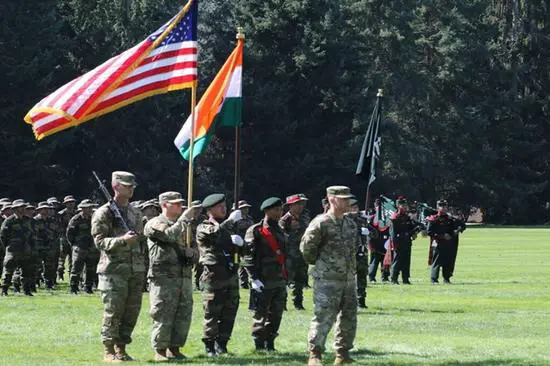*Author: Prof. Engr. Zamir Ahmed Awan, Founding Chair GSRRA, Sinologist (ex-Diplomat), Editor, Analyst, and Non-Resident Fellow of CCG (Center for China and Globalization). (E-mail: [email protected]). *
Indian and U.S. troops on participated in a high-altitude training exercise in a cold, mountainous terrain near a disputed border with China. During the exercise, Indian soldiers were dropped from helicopters to flush out gunmen from a house in a demonstration of unarmed combat skills. Other drills involved sniffer dogs and unmanned bomb-disposing vehicles, and trained kites were deployed to destroy small enemy drones.
The annual drills took place around Auli, a hill station in the northern state of Uttarakhand. The U.S. troops came from the 2nd Brigade of the 11th Airborne Division, and their Indian counterparts were members of the army’s Assam Regiment.
It was an untimely exercise when both countries are trying to manage rising tensions on the Line of Actual Control (LAC). China has shown its concerns much earlier. India and China fought a war along the border in 1962. The latest dispute flared in June 2020, when at least 20 Indian soldiers and four Chinese troops were killed in a brawl in the Ladakh region. It led to the two countries stationing tens of thousands of soldiers backed by artillery, tanks, and fighter jets along the Line of Actual Control. Some Indian and Chinese soldiers have pulled back from a key friction point, but tensions between the two countries have persisted.
Earlier, China's defense ministry said it was firmly opposed to any third party "meddling" in the border issue and hoped India will abide by the bilateral agreements not to hold military drills near the Line of Actual Control (LAC), the very pacts it has been accused of violating in eastern Ladakh leading to a prolonged standoff.
China has always stressed that military cooperation of relevant countries, especially on exercises and training activities, should not be targeted at any third party, but rather serve to help maintain regional peace and stability.
The China-India border issue is a matter between the two countries. Both sides have maintained effective communications at all levels and agreed to properly handle the situation through bilateral dialogues, he said.
In light of the relevant agreements signed by China and India in 1993 and 1996, neither side is allowed to conduct military exercises against the other in areas near the Line of Actual Control, he was quoted as saying by the Chinese Defense Ministry online.
As a result of a series of military and diplomatic talks, the two sides completed the disengagement process last year on the north and south banks of the Pangong Lake and in the Gogra area. So far, the two sides held 16 rounds of Commanders' level talks to resolve the standoff.
The presence of US forces in the region, especially in the disputed area, is a matter of concern, not only for China but also for Pakistan and the whole region. Under the cover of exercises, the US was allowed to survey the region and collected data and geographical information. It was more a spying mission than a military exercise.
India has been facilitating and creating an environment for the US to be involved in the regional conflict. The involvement of third parties may complicate the already complex situation and aggregate the disputes. It is neither in the favor of India nor any other country in the region. It urged that India must think smartly and settle all disputes with all neighbors amicably under the UN Charter through dialogue and diplomatic channels. Involving the US is not desired or optimal.
The US was looking forward to any opportunity to pressurize China as its policy of containing China, and resisting the rise of China. India has disputes with all of its neighbors, including Nepal, Myanmar, Bangladesh, Bhutan, China, Pakistan, Sri Lanka, and Maldives. Will India allow the US to tackle all its neighbors? It should resolve its problems on its own.
The repercussions of US forces in the region might have far-reaching implications and the future course of action with India also depends on how sincere is India to resolve disputes. China has invested in all neighbors of India and enjoys immense goodwill. India is facing isolation in the region and looking at Washington for all its needs.
(ASIA PACIFIC DAILY)
 简体中文
简体中文

